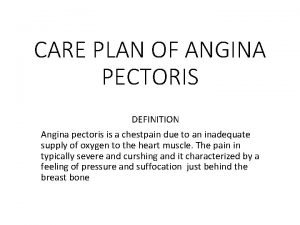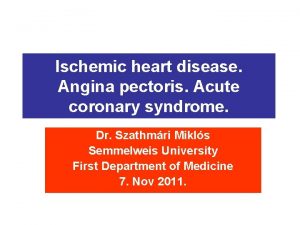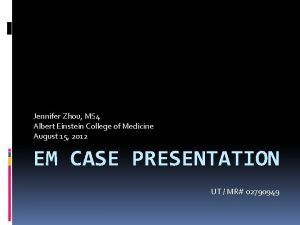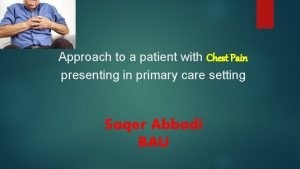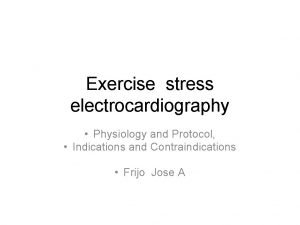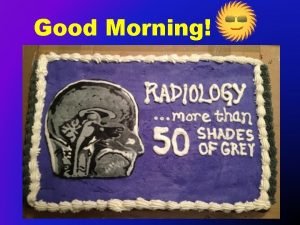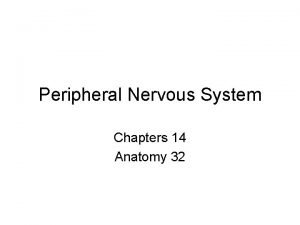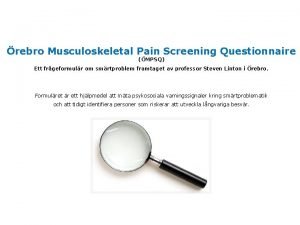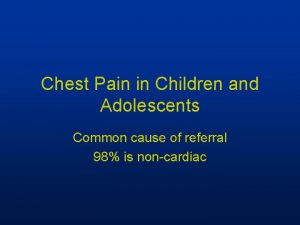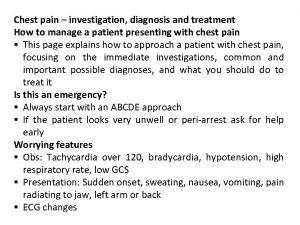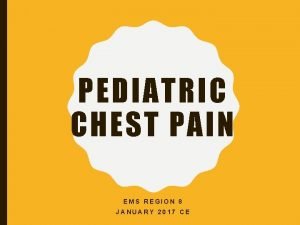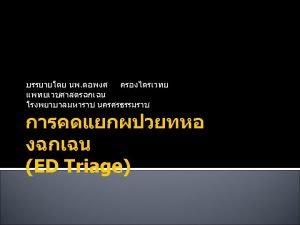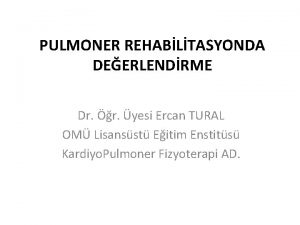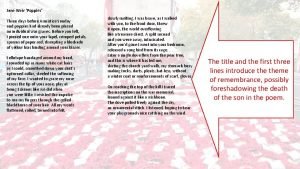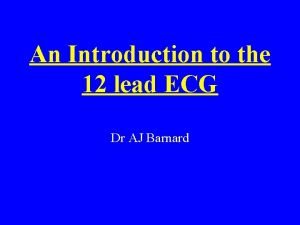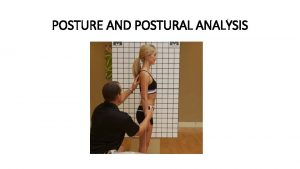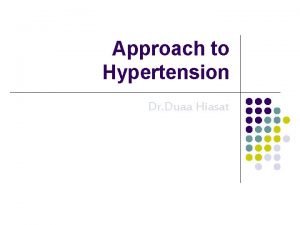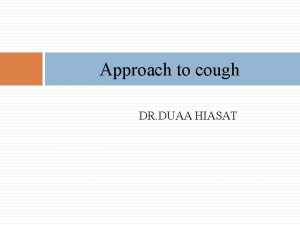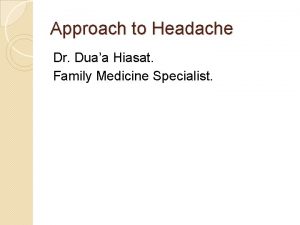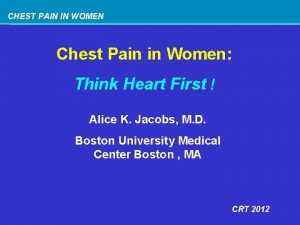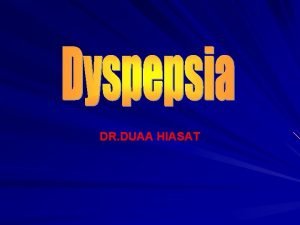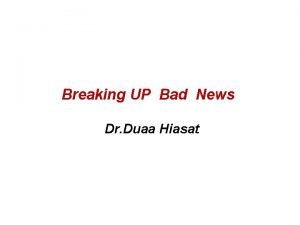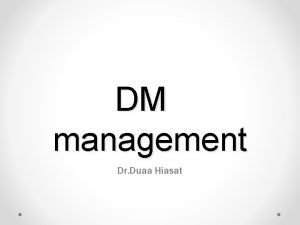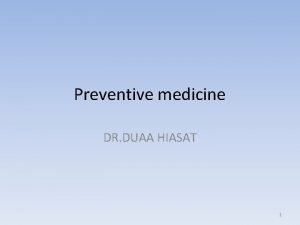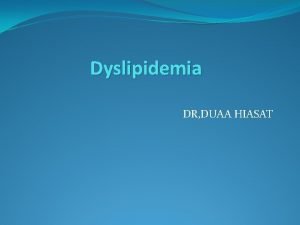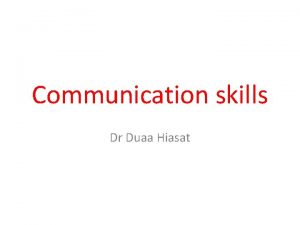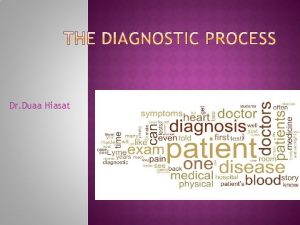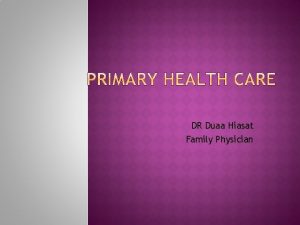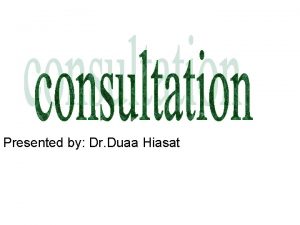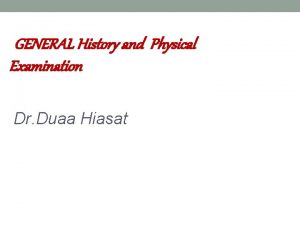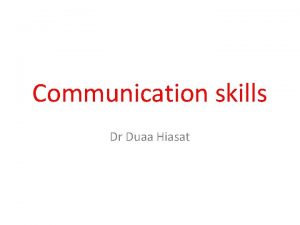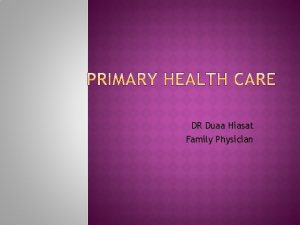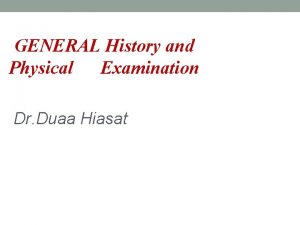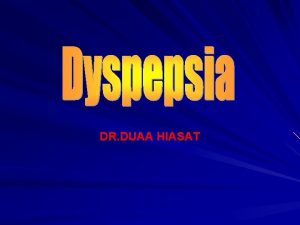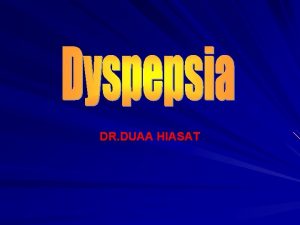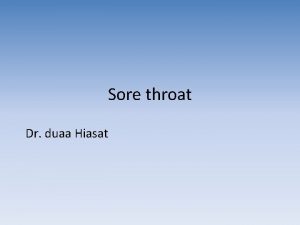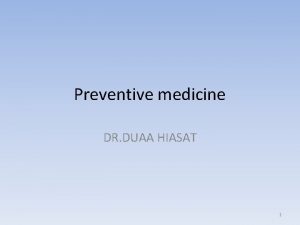Approach to Chest pain Dr Duaa Hiasat Chest
































- Slides: 32

Approach to Chest pain • Dr. Duaa Hiasat

Chest Pain • • • Review of causes Clinical approach Diagnostic evaluation Serious causes & presentation Management of acutely ill ptn Clinical cases

• The prevalence of chest pain etiologies varies according to the population studied. • Differential diagnosis in patients with chest pain: Musculoskeletal 36% (costochondritis, Fibromyalgia) Gastrointestinal 19% (GERD, E. spasm, cholelithiasis) Nonspecific chest pain 16% Stable angina 11% (MI, Angina pectoris, Pericarditis, AD) Psychosocial 7% (somatization, anxiety) Pulmonary causes 5% (PE, Pneumothorax, pneumonia) Other causes of chest pain (AD, AS, pericarditis) 4%

WHAT LIES IN THE CHEST? • • SKIN MUSCLES BONES JOINTS HEART AND VESSELS LUNGS AND AIRWAYS OESOPHAGUS NERVES

CHEST PAIN ASSESSMENT • • • HISTORY EXAMINATION ECG CARDIAC ENZYMES CXR OTHERS

Clinical Approach to Chest Pain • History: A- Pain 1 - Characteristic: Sharp ➔ pericarditis, HZ Squeezing heaviness pressure ➔ MI, Angina Stabbing ➔ pericarditis Pleuritic ➔ PE, Pneumonia Tearing ➔ AD Burning ➔ GERD

Cont’d. . approach 2 - Site of pain: retrosternal, pleural, epigastric) 3 - Radiation: Neck ➔ E. spasm Back (interscapular) ➔ AD Neck, jaw, shoulder, Lt arm ➔ MI, Angina 4 - Onset: Sudden➔ MI, PE, Pneumothorax, AD Gradual ➔ MSS, GI, pneumonia, HZ

Cont’d. . approach 5 - Duration: < 15 min ( 2 - 10) min ➔ Angina Upto 30 min ➔ MI Upto 60 min ➔ E. spasm Few hours ➔ PE, pnumothorax Hours to days ➔ pericarditis Longer ➔ HZ NOTE: <1 min or > 30 sec is less likely to be cardiac.

Cont’d. . approach 6 - Aggravating: Exertion, cold, stress, meals ➔ ischemia , angina Swallowing, postprandial, smoking ➔ GI Deep breathing, movement ➔ MSS, pericarditis Deep breathing ➔ PE, pneumothorax NOTE: HZ is not aggravated by anything

Cont’d. . approach 7 - Relieving factors: Rest or GTN ➔ angina Sitting up, leaning forward ➔ pericarditis Antacid or food ➔ GI causes GTN ➔ E. spasm NOTE: Severity doesn’t indicate seriousness.

Cont’d. . approach 8 - Associated symptoms: Cough, fever, sputum, dyspnea. Sweating. Nausea, vomiting. Heamoptysis. Heartburn, regurgitation. Palpitations. Psychiatric symptoms: Anxiety, depression, panic attack

Cont’d. . approach B- Risk factors: Trauma to chest, unusually severe muscular activity, any infection, malignancy, Hypertension, Hypercholesteramia, DM, Smoking, prolonged immobilization previous DVT, upper G. I. D (PUD, GERD, spasm). C- Family hx : of IHD esp 1 st degree

Physical examination: A- Vital signs: - Hypotension can occur in MI, pericardial temponade, PE, GI bleeding. - Fever suggests an infectious disease. B- Inspection and palpation: - may reveal the rash of shingles, crepitus associated with rib fracture, localized pain, signs of trauma. Hyperesthesia, particularly when associated with a rash, is often due to herpes zoster. C- Cardiopulmonary examination: -In MI may have audible S 4, signs of CHF such as S 3, pericarditis may cause friction rub and pulsus paradoxus, BECK’S TRIAD ( JVP, muffled heart sounds, low BP) suggests cardiac temponade. Determine if the breath sounds are symmetric and if there’s wheezes, crackles etc. .

DIAGNOSTIC EVALUATION: ECG • • Cardiac markers: Troponins are the 1 st enzymes to rise and remain elevated for 5 to 14 days. • Echocardiogram: pericardial effusion, valvular heart disease. • Chest X-ray: Pneumothorax, pnuomonia • Spiral CT, if PE is suspected. • .

• Esophageal p. H monitoring, if GERD is suspected. • Patients with musculoskeletal chest pain might not require any diagnostic testing Life threatening causes: P is Pericarditis. A is as Acute myocardial infarction. P is Pneumothorax P is Pulmonary embolism A is Aneurysm.

Cont’d. . Life-threatening Causes of Chest Pain Angina. Aortic dissection. Spontaneous pneumothorax. Perforated viscus. Cocaine-induced chest pain (accelerates the progression of atherosclerosis, a risk factor for a heart attack. )

Chest Pain That Are Not Immediately Life. Threatening Mitral valve prolapse. Pneumonia. GERD. Esophagitis. Costochondritis. Herpes zoster.

MYOCARDIAL INFARCTION SIGNS • SIGNS OF SYMPATHETIC ACTIVATION PALLOR SWEATING TACHYCARDIA • SIGNS OF VAGAL STIMULATION VOMITING BRADYCARDIA

Myocardial infarction and ischemia • • • Symptoms: CHEST PAIN ANXIETY FEAR OF IMPENDING DEATH BREATHLESSNESS VOMITING COLLAPSE SYNCOPE SILENT

MI INVESTIGATIONS • ECG HELPFUL • DIFFICULT INTERPRETATION IN PREVIOUS MI PATIENTS AND OLD LBBB • RARELY NORMAL ECG • IN 1/3 OF MI CASES INITIAL CHANGES MAY NOT BE DIAGNOSTIC • EARLIEST CHANGE ST ELEVATION • LATER R WAVE SIZE DIMINUTION • Q WAVES IN TRANSMURAL MI • T WAVE INVERSION

RED FLAGS : • Abnormal vital signs (tachycardia, bradycardia, tachypnea, hypotension) • Signs of hypoperfusion (eg, confusion, diaphoresis) • Shortness of breath • Asymmetric breath sounds or pulses • New heart murmurs • Pulsus paradoxus > 10 mm Hg

Myocardial Ischemia or Infarction(ACS) • Management: (MONALISA) Morphine for pain(5 -10 mg) if no morphine Pethidine (75100 mg) + anti emetic. PROVIDING systolic BP is more than 9060. Oxygen if hypoxic Nitro spray/drip for pain Aspirin Lasix if in congestive heart failure Inotropes if in cardigenic shock Streptokinase (thrombolytics) Anticoagulation (non Q wave MI Heparin or LMWH, Q wave MI Thrombolytic and Heparin/LMWH) Other drugs: B-blocker ( HR, # CHF) ACEi, CCB (# LV Failure) NOTE: When immediate percutaneous transluminal coronary angioplasty (PTCA) is available immediate revascularization my be preferable to thrombolytic therapy.

Angina Site MI Retrosternal radiates to neck jaw shoulder Lt arm. MORE sever AD Pericarditis Anterior chest may radiate to back Substernal may radiate to neck or Lt shoulder Nature Squeezing, pressure, heaviness Tearing Stabbing Duration 2 – 10 min Usually 30 mins Pt usually had HTN or Marfan Hours to days ------- Deep breathing, supine, rotation of chest ------ Sitting, leaning forward Aggravat ed Relieved Associated Exertion, cold, emotional stress Rest or GTN Not relived by rest or GTN Dysnea Neause, vomiting, weakness, sweating Rub

PERICARDITIS • Constant or intermittent sharp pain often aggravated by breathing, swallowing food, or supine position and relieved by sitting leaning forward • Pericardial friction rub • Jugular venous distention. • ECG usually diagnostic ST segment elev. , T wave inversion, or PR depression • Serum cardiac markers (showing elevated troponin with normal CPK level

AORTIC DISSECTION ■ ■ ■ ■ ■ TEARING PAIN ABRUPT ONST COLLAPSE Patient APPEARS TO BE IN SHOCK BP---NORMAL OR RAISED ASYMMETRY OF PULSES MI ACUTE ABDOMEN(MESENTERIC CAELIAC) RENAL FAILURE ACUTE LIMB ISCHEMIA(LEGS)

RESPIRATORY CAUSES

Pneumonia Hx: Sharp & pleuritic pain, SOB, cough, fever, hx of URTI. PE: dull on percussion, bronchial breathing sound, pleural rub, crackle. Commonest cause: Strept Pneumonia. Dx: Sputum samples, blood test(WBCs), CXR, bronchoscopy. Rx: antibiotics(amoxicillin, penicillin, clarithrimycin, macrolides)

Pulmonary Embolism History: • Sudden-onset, sharp • Exacerbated by inspiratory effort • Associated with hemoptysis, syncope, dyspnea, calf swelling/pain from DVT Physical: • Anxious patient, sense of impending doom. • Tachycardia, tachypnea, hypoxia. • If severe, can get hypotension, syncope, and RV failure (↑JVP, RV heave)

MUSCULOSKELETAL CHEST PAIN ■ ■ ■ VARY WITH POSTURE • ARTHRITIS VARY WITH • COSTOCONDRITIS POSITION • INTERCOSTAL LOCAL TENDERNESS MUSCLE INJURY • COXSACKIE VIRAL INFECTION • MINOR SOFT TISSUE INJURIES

GIT CAUSES

GERD. • Recurrent burning pain radiating from epigastrium to throat that is exacerbated by bending down or lying down and relieved by antacids. • Clinical evaluation Sometimes endoscopy Sometimes motility studies

OESOPHAGEAL PAIN • • • CAN MIMIC ANGINAL PAIN MAY GET PRECIPITATED BY EXERCISE MAY BE RELIEVED BY NITRATES RELATION WITH SUPINE POSITION, EATING, DRINKING H/O REFLUX CAN RADIATE TO BACK
 Dua of imam zainul abideen
Dua of imam zainul abideen Ux research portfolio
Ux research portfolio Dua for marhumeen
Dua for marhumeen Allahumma hazi shahre ramadan
Allahumma hazi shahre ramadan Angina pectoris nursing care plan
Angina pectoris nursing care plan Typical chest pain
Typical chest pain Afebrile vss
Afebrile vss Causes chest pain
Causes chest pain Mason liker
Mason liker 50 shades of chest pain
50 shades of chest pain Sympathetic trunks
Sympathetic trunks Mpsq
Mpsq Chest pain in pediatrics
Chest pain in pediatrics Retrosternal chest pain
Retrosternal chest pain Stabbing pain in chest
Stabbing pain in chest The canadian ed triage and acuity scale
The canadian ed triage and acuity scale Do you still get period cramps when pregnant
Do you still get period cramps when pregnant Signs of period vs pregnancy
Signs of period vs pregnancy Martian pain
Martian pain What is research approach definition
What is research approach definition Country attractiveness matrix
Country attractiveness matrix Diagram for traditional approach
Diagram for traditional approach Multiple approach-avoidance
Multiple approach-avoidance Deep learning approach and surface learning approach
Deep learning approach and surface learning approach Difference between datagram and virtual circuit
Difference between datagram and virtual circuit Cognitive approach vs behavioral approach
Cognitive approach vs behavioral approach Theoretical models of counseling
Theoretical models of counseling London chest günlük yaşam aktiviteleri ölçeği
London chest günlük yaşam aktiviteleri ölçeği Chest pediatric pulmonary board review
Chest pediatric pulmonary board review Fcps pulmonology
Fcps pulmonology Gelled blackthorns of your hair
Gelled blackthorns of your hair Hyperacute t waves
Hyperacute t waves Ectomorphic
Ectomorphic




